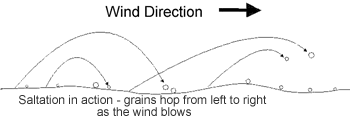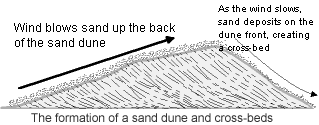BACKGROUND:
Water is a very powerful erosional force on the
surface of the Earth. Flowing water, as a liquid or solid (ice), is very
effective at eroding and transporting loose material from high places to low
places. Mountains are worn down, and valleys, lakes, and part of oceans are
filled in.
Wind is also important in shaping the Earth’s
surface. Wind is caused by the movement of gas molecules in the Earth’s
atmosphere, in response to changing atmospheric pressures. Wind is not as
effective or "violent" an agent of erosion as are ice and water,
but over time it can transport much material and finely sculpture a
landscape. Wind is capable of transporting loose, unconsolidated fragments
of sand and dust. Larger particles are too heavy for normal winds to move,
except in storm  conditions.
conditions.
Normal winds are barely strong enough to move sand, so
this material moves by an intermittent series of jumps or skips along the
Earth’s surface. This transport process is called saltation. Dust
particles are light enough that they can be picked up and fully transported by
the wind. This allows dust to blow long distances, even across wide ocean
basins.
Sand dunes are mounds of sand that have been piled up
and transported by the wind. They commonly form in dry Earth surface
environments. Viewed from one end, sand dunes have a flat back side and a
steep front side. The wind blows up the back side of the dune. If the wind
blows fast enough, it will pick up and transport sand grains up the back of
the dune. When the wind goes over the top of the dune, it slows down. This
causes it to drop the sand grains it was carrying. The sand lands on the
steep front of the dune. This forms an inclined layer of sand, called a
cross-bed. The cross-bed gets flatter at the bottom because some of the sand
rolls down to the bottom of the dune and piles up. As more and more sand
blows through an area, many cross-bedded layers of sand accumulate. This
process causes a sand dune to migrate down wind. Sand is continually eroded
from its upwind side, and deposited on its downwind side.
 Water and wind are both effective surface processes on
the Earth. The Earth is just the "right" distance from the Sun
that liquid water is abundant on its surface. The reasons for this are
complex. Essentially, the amount of solar radiation that the Earth receives,
combined with the concentrations of greenhouse gases in the atmosphere, keep
the temperature in the proper zone for water to be liquid. If the Sun were
cooler or if there were less greenhouse gases, ice would be more abundant.
If there were more of either of these, much liquid water would evaporate.
Wind erosion and transport is common on the Earth because it has an
atmosphere.
Water and wind are both effective surface processes on
the Earth. The Earth is just the "right" distance from the Sun
that liquid water is abundant on its surface. The reasons for this are
complex. Essentially, the amount of solar radiation that the Earth receives,
combined with the concentrations of greenhouse gases in the atmosphere, keep
the temperature in the proper zone for water to be liquid. If the Sun were
cooler or if there were less greenhouse gases, ice would be more abundant.
If there were more of either of these, much liquid water would evaporate.
Wind erosion and transport is common on the Earth because it has an
atmosphere.
In contrast, neither water nor wind are effective on
the Moon. It lacks an atmosphere, so there is little wind to blow on the
lunar surface. The Moon also has little if any water on its surface. Any
water that may be present is frozen. At present, the main factors that shape
the lunar landscape are impacts and the formation of craters, and occasional
landslides caused by gravity.
PROCEDURE:
- Introduce students to wind erosion and transportation. Make sure the
students understand that an atmosphere is necessary for wind to blow.
Explain saltation, and the formation of sand dunes. You may wish to have
them complete the first three questions on the worksheet as you lecture.
- Have the students speculate about the presence or absence of wind
erosion on the Moon. Discuss their answers as a group, and have them
complete the worksheet.
- ANSWERS: 1. and 2. see the drawings above. 3. No, because
without movement of the wind, sand would not be piled up into dunes.
Water and ice might move the sand from place to place, but would not
make sand dunes. 4. No, because the Moon does not have an atmosphere.